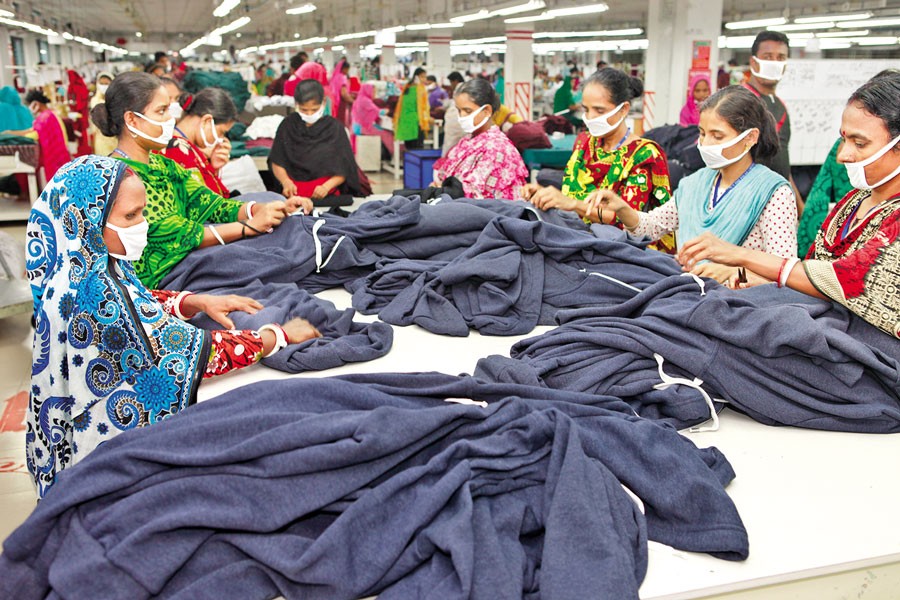 RMG workers at a factory in Dhaka — FE Photo
RMG workers at a factory in Dhaka — FE Photo  The World Bank (WB) has slashed its economic growth projection for Bangladesh for the current fiscal year because of higher inflation, energy shortage, slowdown of recovery from the pandemic, and the war in Ukraine. Gross Domestic Product (GDP) growth is now expected to grow by 6.1 per cent in FY23 and not by 6.7 per cent, as projected earlier in June. This was revealed in the WB's South Asia Economic Focus titled "Coping with Shocks: Migration and the Road to Resilience" on 6 October. It needs to be noted that the projected growth is the lowest since 2019-20 when it fell to 3.45 percent as the pandemic brought the economies around the world to their knees. It may also be recalled that in September, the Asian Development Bank also cut its projection for Bangladesh's gross domestic product (GDP) growth to 6.6 per cent this fiscal year from 7.1 per cent. Our government had set an ambitious economic growth target of 7.5 per cent for the current fiscal year.
The World Bank (WB) has slashed its economic growth projection for Bangladesh for the current fiscal year because of higher inflation, energy shortage, slowdown of recovery from the pandemic, and the war in Ukraine. Gross Domestic Product (GDP) growth is now expected to grow by 6.1 per cent in FY23 and not by 6.7 per cent, as projected earlier in June. This was revealed in the WB's South Asia Economic Focus titled "Coping with Shocks: Migration and the Road to Resilience" on 6 October. It needs to be noted that the projected growth is the lowest since 2019-20 when it fell to 3.45 percent as the pandemic brought the economies around the world to their knees. It may also be recalled that in September, the Asian Development Bank also cut its projection for Bangladesh's gross domestic product (GDP) growth to 6.6 per cent this fiscal year from 7.1 per cent. Our government had set an ambitious economic growth target of 7.5 per cent for the current fiscal year.
According to Bangladesh Bank, in the first two months (July-August) of the current fiscal year, goods worth $12.69 billion have been imported against exports worth $8.13 billion. This has created a trade deficit of $4.55 billion. This regressive scenario has been further affected because of reduction in our receipt of remittances from our migrant workers working abroad.
According to the WB report, GDP growth is projected to decelerate slightly in 2022-23 due to the slowdown of post-Covid recovery in consumption and investment. In this context the WB has noted that- "higher inflation is expected to dampen private consumption growth, following substantial energy price increases. Export growth is also expected to slow as economic conditions in the key export markets deteriorate, while rolling blackouts, gas rationing, and rising input costs weigh on manufacturing output."
However, Bangladesh is not alone within this unfortunate paradigm. The WB has reduced its growth forecast also for other South Asian countries- India, Pakistan, Sri Lanka and the Maldives. It has revised downwards the growth projection for India by 0.1 percentage points to 7 percent, for Pakistan by 2 percentage points to 2 per cent, for Sri Lanka by 0.5 percentage points to a negative 4.2 per cent, and for the Maldives by 2 percentage points to 8.2 per cent. It has however raised the economic growth outlook for Nepal by 1 percentage point to 5.1 per cent.
Through a virtual press briefing, WB Chief Economist for South Asia Hans Timmer has pointed out that this economic erosion in Bangladesh has taken place because it is one of the countries that have been hit hard by recent developments- especially the increase in commodity prices and the slowdown in high-income countries, particularly in Europe. Analysts have since elaborated that since Bangladesh exports a lot of readymade garments (RMG) to Europe, high commodity prices have led to a sharp increase in the cost of the garment industry. According to Timmer, this has been a big hit for Bangladesh as it relies largely on the RMG industry for about 85 percent of its exports. This has also clearly led to the weakening of its currency and a decline in the foreign exchange reserves.
This scenario and the balance of payments pressure have in turn resulted in Bangladesh, Sri Lanka and Pakistan to request the International Monetary Fund for support.
However, unlike the two other countries, Bangladesh's reserves have not fallen to dangerously low levels. The country, unlike Pakistan and Sri Lanka, is also not facing political instability and inflation is still below 10 percent. Nevertheless, it is clear that to avoid sinking in the emerging quagmire, diversity in approach, reduction of different forms of informal and illicit foreign exchange transactions not recorded at any official level and reorientation of resilience is necessary.
Dr Debapriya Bhattacharya, a macro-economist, has pointed out that Bangladesh is now a $500 billion economy, but managing such an emerging macro-economy with a fast-changing global scenario demands institutional reforms to swiftly oversee the foreign exchange market. We, he has correctly suggested, need complementary trade and investment policy reforms.
Jagaran Chakma has recalled that the first Industry and Investment Policy was formulated in 1973 and then revised in 1975. Another industrial policy was formulated in 1982, removing the word "investment" from its title. Since then, the industrial policy has been formulated nine times with amendments. To this, one also needs to carefully re-visit our Industrial Policy, 2022 and identify areas and aspects that can improve our mode related to efficiency. The policy, which will be valid until 2027, will give priority to small and medium enterprises in order to generate employment opportunities and ensure higher growth.
In particular, there is a need to identify better areas of coordination between the line Ministries and the associated stakeholders. The effort being aimed at through the new policy is meant to increase the industrial sector's contribution to the country's gross domestic product (GDP) to 40 per cent from present 35 per cent within the next five years.
Our Ministry of Industry has issued a notification highlighting the need to develop skilled manpower and increase productivity and employment to expand the sector's GDP contribution by 5 per cent within 2027. Abul Kashem Khan, former chairperson of Business Initiative Leading Development (BUILD), has in this context pointed out that the lack of efficiency; coordination and cooperation in implementation have been important challenges. In addition, according to the industrialists, there needs to be conformity and continuity in terms of policy initiated by our National Board of Revenue to facilitate the attraction of foreign direct investment. Frequent changes would impair this possibility.
Khondaker Golam Moazzem, research director of the Centre for Policy Dialogue, has noted that the new policy has made some improvements- as an action plan for implementation has been incorporated along with a detailed explanation on industry clusters. He has also suggested forming a monitoring strategy to evaluate the implementation status every six months and place a report to the implementation committee.
In addition, it has been reiterated that the industries ministry should formulate a guideline for other stakeholders to implement the policy. This will require clarification about the potential Bangladesh Bank's framework for financing women entrepreneurs. The central bank policy mentions reserving 5 percent of loans for women while the industrial policy wants to provide them with 25 per cent of the total fund for industrial loans. Besides, a clause has been kept to ensure that 15 percent of the plots at various economic zones, export processing zones and hi-tech parks are reserved for women entrepreneurs. Similarly, 25 percent of the total loan allocation for the SME sector will be kept in favour of women entrepreneurs, including coverage of the SME Foundation, while the Bangladesh Small and Cottage Industries Corporation (BSCIC) will work to expand the market for their products.
Senior officials of the Industries Ministry are formulating an action plan to promote awareness about the nuances of this policy among entrepreneurs, investors and other public stakeholders and line ministries to comply with the policy which has set a target to develop the country's socio-economic condition through inclusive growth aimed at achieving sustainable and eco-friendly industrialisation. The issue of environmental conservation has also been focused upon by emphasising that the establishment of factories has to be in designated areas.
This policy will also aim to develop a strong foundation for the domestic light engineering sector through the adoption of sustainable and sophisticated technology. The new policy will also attach importance to the IT sector in order to help related industries improve their efficiency and productivity.
These measures are being taken to ensure product diversification of potential export items and capacity building in the industrial sector that will be needed to face the challenges of Bangladesh's graduation from the LDC status.
Considered as a potential sector for resolving the unemployment problem, the policy has also drawn attention to the need for developing cottage, micro, small and medium enterprises (CMSMEs) as this sector has been playing a significant role in achieving economic growth and earning foreign currency by encouraging and expanding business activities in the rural areas.
And like previous editions, the new policy focuses on product diversification, skills development, policy reforms, private sector-led economic transformation, technology adaptation, and adequate training.
It is understood that the relevant authorities will also undertake a countrywide awareness programme to ensure innovation and protection of intellectual property rights in line with the Trade Related Aspects of Intellectual Property Rights (TRIPS). This required initiative will be taken to incentivse the production of import substitute products. It is correctly believed that such a creative spectrum will provide stimulus incentives for big foreign investors who might consider shifting their industries to Bangladesh.
There is also the socio-economic matrix in Bangladesh which is carefully monitored by many analysts all over the world. One has to refer in this regard to an interesting dimension within the RMG industry and the apparel export that it generates.
R.U.Mirdha has mentioned that our apparel export might be able to "hit" $95 billion by 2030 "if the country can expand its share in the global market for manmade fibre (MMF) to 12 per cent from less than 5 per cent at present". A recent study has revealed that MMF apparel items "accounted for $222 billion of the $440 billion global garments market last year, when cotton-based products contributed $190 billion". As such, almost half of all apparel exports worldwide are of MMF products while 42 per cent are cotton-based garment items. However," the picture is reversed in Bangladesh, where 72 per cent of the garment exports are cotton-based apparels and just 24 per cent are MMF".
The global demand for MMF-based apparel items has been growing because of uncertainty in cotton production and supply, price comparability, and certain advantages offered by such products, namely higher durability, water and wrinkle resistance, and colour retention.
Apparently of the total $42 billion apparel exports from Bangladesh in the last fiscal year, $30 billion were cotton-based garment items.
These factors are now persuading environmental analysts to suggest that Bangladesh should carefully study and ascertain how much they can participate within the MMF process. Not a bad idea at all in terms of creativity.
Muhammad Zamir, a former Ambassador, is an analyst specialized in foreign affairs, right to information and good governance.
muhammadzamir0@gmail.com
© 2025 - All Rights with The Financial Express
